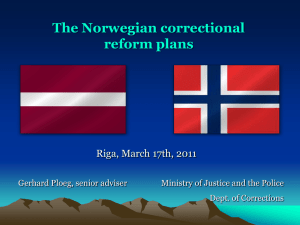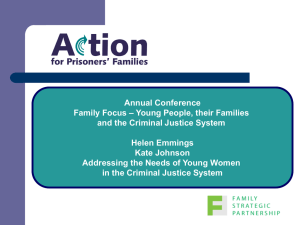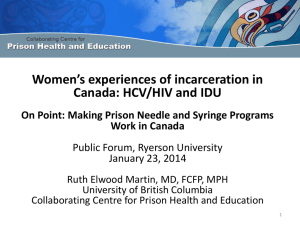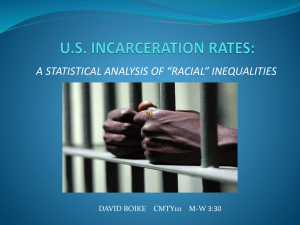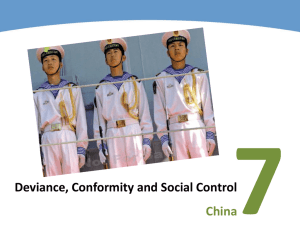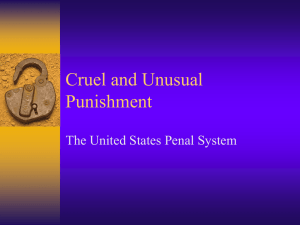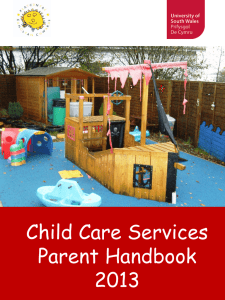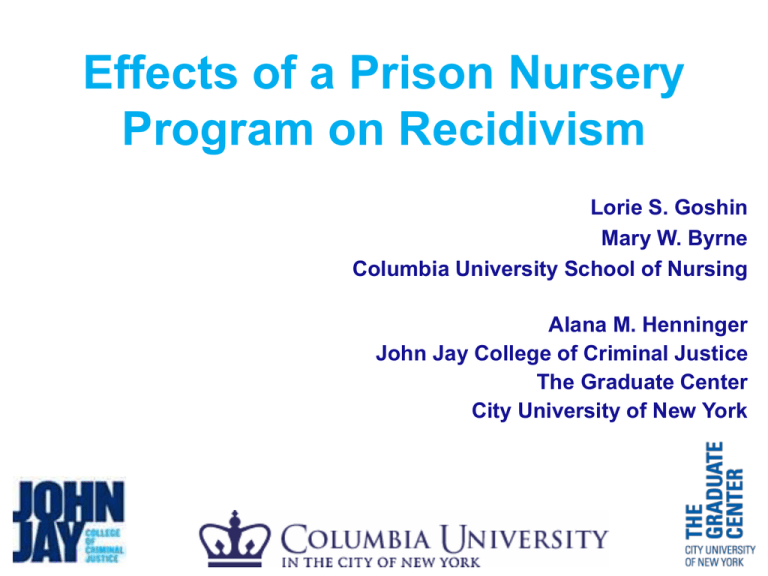
Effects of a Prison Nursery
Program on Recidivism
Lorie S. Goshin
Mary W. Byrne
Columbia University School of Nursing
Alana M. Henninger
John Jay College of Criminal Justice
The Graduate Center
City University of New York
Acknowledgements
• Research Participants
• Studies: “Maternal and Child Outcomes of a Prison Nursery
Program”, Principal Investigator Mary Byrne
• Funders:
– National Institutes of Health/National Institutes of Nursing
Research RO1 NR00782, 2003-2013
– Columbia University Institute for Child and Family Policy
– NYS Department of Health Commissioner’s Priority Award
On any given day in the US….
1 in 746 women are in prison or
jail
Are under some form of criminal
justice control
Pew Center on the States (2008, 2009). One in 100: Behind bars in America 2008. retrieved from
http://www.pewcenteronthestates.org/uploadedFiles/8015PCTS_Prison08_FINAL_2-1-1_FORWEB.pdf
Pew Center on the States (2009). One in 31: The long reach of American corrections. Retrieved from
http://www.pewcenteronthestates.org/uploadedFiles/PSPP_1in31_report_FINAL_WEB_3-26-09.pdf
Criminal Justice Involvement &
Health Disparities
• Higher prevalence of asthma, high blood pressure,
mental illness, substance use disorders, hepatitis,
HIV/AIDS, and other sexually transmitted infections
than general adult population (Fazel & Baillargeon,
2010).
• ≈ 20-26% of all Americans infected with HIV, 29-43%
with Hep C, 40% with TB passed through a correctional
facility in 1997 (Hammett, Harmon, & Rhodes, 2002)
• Incarcerated women are more likely than incarcerated
men to report:
• Medical, mental health, and substance use disorders
(Binswanger, Merrill, Krueger, White, Booth, & Elmore, 2010)
• A lifelong history of trauma and exposure to adverse
childhood events (Messina et al., 2007)
Imprisoned Women and
their Minor Children
160,000
140,000
120,000
Mothers in Prison
100,000
80,000
Minor Children of
Mothers in Prison
60,000
40,000
20,000
0
1991
1997
Glaze, L.E., & Maruschak, L.M. (2008).
1999
2004
2007
Prison Nursery Programs
• Allow women to live with their children in
correctional settings
• Prison Nurseries: 8 prisons in 8 states
– General eligibility criteria:
1) Pregnant upon admission,
2) Convicted of a nonviolent crime,
3) Expected release date 12-18 months after due
date,
4) No history of crimes against children.
New York State’s Prison Nursery
History
New York State Corrections Law §611
– Signed into law in 1930 by FDR, then Governor of New York.
Remains virtually unchanged.
– Gives eligible women the right to care for infants born in
custody
– Length of stay: up to 1 year, up to additional 6 months if
mother’s release date expected between 12-18 months of age
– Gives superintendent and medical officer broad discretion
– Includes shackling language since 2009
Implementation of §611
– Eligibility: Main screening goal to determine whether an applicant
would threaten the safety of other nursery participants
– History of violence and indicated child welfare cases are
reviewed closely and generally denied entry
– Prison disciplinary record reviewed
– Best interest of the child as guide
New York State’s
Prison
Nursery
Operations
Photo by Joseph Rodriguez (2001)
• Funded by DOC. Managed by non-profit social
service agency. Staffed by civilians & corrections
• Facility: Segregated from general population. Can
house <= 29 mothers and infants
• Working Mother Model: daily childcare provided to
facilitate attendance in other educational and
rehabilitative programs
• Mandated parenting course and weekly group
meeting
Prison Nursery Outcomes:
Recidivism
• Rates of return to prison appear lower than
offenders from general population
• Nebraska: 16.8% 3 year rate for women who completed
the program (Carlson, 2009)
• New York: 13% 3 year rate for women released in 1997
(NYSDOC, 2001)
• Washington State: 15% return to prison within
unspecified time frame (Roland & Watts, 2007)
• Methodological limitations in available research
• Data sources unspecified or unsystematic (e.g.,
nursery staff, self report of women who could be
located)
• Time frames not standardized
• Recidivism not well defined- Alternately used for return
Methods
• Recruitment from Bedford Hills and Taconic
prison nurseries
• Total N = 139
– Cross-Sectional Phase 2001
• N = 56 women, 58 children
– Longitudinal Phase 2003 – 2007
• N = 97 women, 100 children
– Excluded N = 14 (Deported or imprisoned in
another state on release, Youthful offender, not
yet in the community for 3 years)
Measurement & Data Analysis
• 3 Year Recidivism: 1) Felony Reconviction,
2) Prison Reincarceration
• Data sources:
– Primary data from prison nursery studies
– New York State Department of Criminal Justice Services
unsealed data matched by criminal justice identification
number. Cross checked by birth date and nursery
incarceration date.
• Data Analysis:
• Kaplan-Meier for Categorical (Nursing intervention,
Minority, Release with baby, PV). Substance abuse
history not explored due to lack of variability.
• Cox Regression for Continuous (Age at release, Length
of Stay, Prior Arrests)
Sample Description
• Time on Nursery M = 6.9 months (SD = 4.7)
• Age at release = 29 years (SD = 6.4, Range 18 –
49)
• Race/Ethnicity:
– Black (African, African-American, AfroCaribbean) 42%
– Latina 27%
– White 31%
• Mother and child released together 66%
• Substance abuse history 77%
• Clinically significant depression symptoms 75%
Criminal Justice History
• Conviction:
– Drug Sales or Possession: 54.7%,
– Property Crime: 24.1%
– VFO (Assault, Robbery, Negligent Manslaughter):
14.6%
– Other (DUI, conspiracy, leaving the scene,
weapons): 6.5%
• Nursery incarceration due to PV 24.6%
• Unsealed prior arrests M = 4.0 (SD = 5.8)
• Unsealed prior convictions M = 3.0 (SD = 3.9)
Results:
3 Year Felony Reconviction
• 6.5% (N = 9)
• Crimes:
– Drug Sales or Possession (N = 2)
– Property (N = 5)
– VFO (N = 2)
• Mean time to reconviction = 20.6 months
(SD = 9.8)
Results:
3 Year Return to Prison
• 13.7% (N = 19)
New Commitment: 4.3% (N = 6)
Parole Violation: 9.4% (N = 13)
• Predictors of Return to Prison:
– Women in the nursery on PV 2 ½ times
more likely to be reincarcerated by 3 years
(HR = .42, p = .06)
Nursery Incarceration for PV
Not in nursery for PV
Nursery for PV
Mantel-Cox χ2 = 3.8, p = .05
Nursery Incarceration for VFO
No VFO
VFO
Mantel-Cox χ2 = .76, NS
Race/Ethnicity
African-American or Latina
White, non-Latina
Mantel-Cox χ2 = .49, NS
Baby Released with Mother
Alternate Caregiver
Mother
Mantel-Cox χ2 = .65, NS
Discussion
• Women released from a prison nursery program
have very low likelihood of felony reconviction or
return to prison within 3 years
• Sample at high risk for recidivism:
– Younger women
– Drug offenders
– Property offenders
Discussion
Comparison between prison nursery recidivism and all
women released from NYS prisons in 2007 and 1985-2007
New Commitment
Parole Violation
4.3%
9.4%
1985-2007 Cohort
8.9%
20.4%
2007 Cohort
4.5%
29.3%
Prison Nursery
All Female NYS Releases
Conclusions
• Consider prison nurseries with supportive services as
a best practice in corrections for imprisoned pregnant
women
Cost efficiency: partnership with local non-profits
Quality: positive infant and preschool outcomes,
low recidivism
X Access: LIMITED
• Compared to what? Quasi-Experimental research
needed to compare prison nursery residents to
– Women in states without access to prison nursery
– Women allowed to remain in the community with their
infants and older children.
Thank you!
For more information please
contact:
Mary W. Byrne, PhD, MPH
mwb4@columbia.edu


